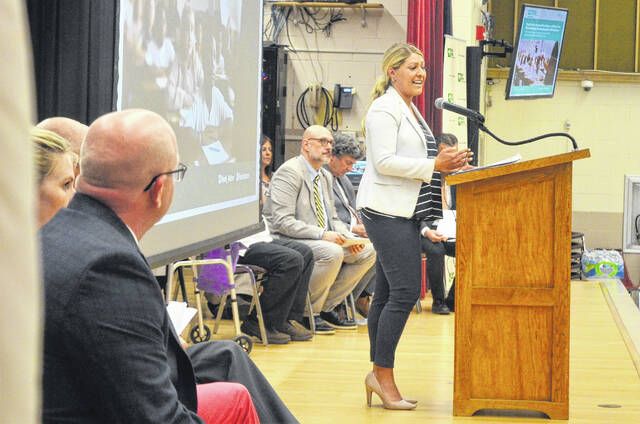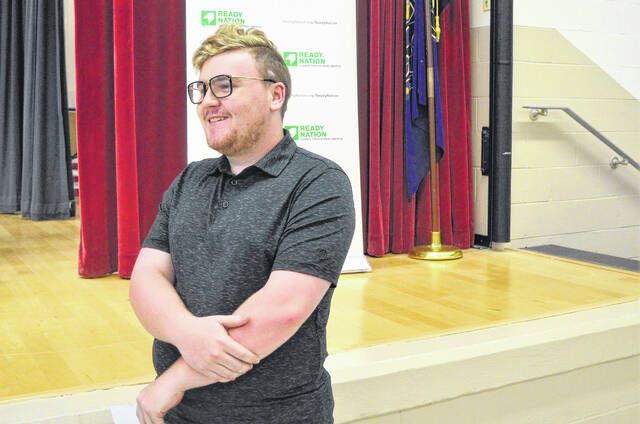
Greater Wyoming Valley Chamber of Commerce President Lindsay Griffin discusses a new report by Ready Nation warning of a rapidly growing shortage of trained workers in the state and the country at a media conference in the cafeteria of the Wilkes-Barre Area Career and Technology Center Thursday.
Mark Guydish | Times Leader
Click here to subscribe today or Login.
PLAINS TWP. — The workforce statistics cited during a media conference at Wilkes-Barre Area’s Career and Technology Center Thursday were bleak.
The COVID-19 pandemic rewrote workforce rules, and despite a substantial rebound, 382,000 jobs statewide remain open, up nearly 26 percent from 2021. Greater Wyoming Valley Chamber of Commerce President and CEO Lindsay Griffin noted trends threaten to make the worker shortage bigger soon.
The number of Pennsylvanians reaching retirement age is now 60,000 per year. Half of the current workforce is over the age of 45, and one quarter is over the age of 55.
The numbers came from a new report by “Ready Nation” and “Council for a Strong America.”
The former bills itself as business executives building a skilled workforce, while the latter “is a national, bipartisan nonprofit that unites membership organizations, including law enforcement leaders, retired admirals and generals and business executives that promote solutions ensuring that our next generation of Americans will be successful, productive members of society.”
The report cites findings from various studies showing the need for better training and more people being trained.
In a 2019 survey by the PA Chamber of Business and Industry, employers identified “the lack of qualified applicants to fill job openings” as the “single most important issue facing Pennsylvania Business.”
Monster.com’s 2022 global report found “more than 9 out of 10 employers (nationally) say they are struggling to fill positions because of a skills gap, and 29% agree that the skills gap has increased compared to a year ago.”
And it’s hurting the economy, nationally and locally.
“The Federal Reserve Bank of Atlanta has estimated that current staffing shortages are costing U.S. businesses more than $60 billion a month in lost sales,” according to the report. “Another study has estimated that by 2029, the national demand for workers with an associate degree or some college could be about 800,000 higher than the supply, while the shortage for workers with a bachelor’s degree or higher could be about 8.6 million.”
In Pennsylvania, the shortage of workers with associate or bachelor degrees is expected to translate into “lost economic output to the Commonwealth is in excess of $66 billion.
Greater Pittston Chamber of Commerce Executive Vice President Michelle Mikitish said the lack of training and workforce shortage could mean $4.5 billion lost in local wages.
A critical component in combating the workforce shortage, speakers at the media conference said, is adequate and equitable funding for public education, including career and technology centers.
Griffin noted that “80% of students attend traditional K-12 schools and career and technology centers,” making them the surest place to build the next generation of career-ready graduates. “The report notes that scores on school assessments and graduation rates are substantially higher in wealthier school districts.”
Inconsistent and insufficient state funding for public education has long meant districts must rely more heavily on local property taxes, with some districts having wealthy residents and large tax bases while others struggle with poorer residents and smaller tax bases. Mikitish said that state-wide, “the poorest 20% of school districts spend $5,000 less per pupil than the wealthiest 20% of districts.”
With the cafeteria full of students, CTC Administrative Director Anthony Guariglia said that more money for the center would mean more students getting the training employers need, allowing CTCs to offer more classes and avoid creating waiting lists when demand grows for a given training.
CTC Principal Frank Majikes pointed out that the school has about 100 students getting cooperative education that lets them get real-world experience with area employers and business, and that of those, 90% will be offered positions with the companies upon graduation.
Electrical construction teacher David Namey offered a familiar battle cry of those who push for greater state funding of public education.
“A student’s ZIP code should not determine the educational opportunities provided to them.” And one of Namey’s students, Senior Robert Miller who expects to follow in the footsteps of his father and grandfather by becoming an elevator contractor, called the CTC’s training “unbelievable.”
State Rep. Mike Carroll, D-Avoca, echoed Gov. Tom Wolf’s contention that this is a good year to boost public school spending in the state budget, as Wolf has proposed. The state has a large surplus thanks to federal pandemic relief funds and revenues coming in higher than expenditures. In the past, financial constraints and political bickering have led to small increases in public education at best.
“We cannot do it on the cheap any longer,” Carroll said. “And we have the money.”
Reach Mark Guydish at 570-991-6112 or on Twitter @TLMarkGuydish






